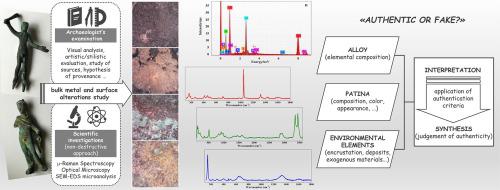Journal of Archaeological Science: Reports Pub Date : 2021-07-17 , DOI: 10.1016/j.jasrep.2021.103115 Antonella Privitera 1 , Andrea Corbascio 2 , Giuliana Calcani 3 , Giancarlo Della Ventura 4 , Maria Antonietta Ricci 1 , Armida Sodo 1

|
Illicit trade in archaeology is a widespread phenomenon connected to the market of archaeological objects from clandestine excavations or faking manufacture, which includes bronze objects. As a consequence, authentication and provenance studies are required on objects of unknown provenance when they are recovered thanks to the investigation activity of the police, before returning them to the museums. Various strategies and approaches can be used to identify fake bronzes, as for instance patinas studies, since the corrosion can spontaneously occur over time, due to the interaction of the surface with the environment, or induced by artificial treatments, performed to mimic the archaeological aging effects in short time. The artificial patina has outward appearance and colours very similar to the natural patinas, but with different mineralogical composition. In this work, Raman spectroscopy is used to discriminate between artificial and natural patinas by a non-destructive approach, supported by the microanalysis SEM-EDS and optical microscope observations in the case of two ‘Etruscan-Roman’ bronze statuettes of illicit and unknown provenance, and demonstrates their recent and fake manufacture. Indeed, the patinas of both statuettes contain covellite, antlerite, langite, chalcanthite and rouaite, minerals or metastable chemical species traced back to corrosion induced by chemical attack and thermal treatment, as distinct from their stable polymorphs usually formed in burial condition. Moreover, we have not found evidence of the presence of malachite and azurite, typical of natural aged patinas. Finally, the abundance of Zn in the alloy suggest a modern manufacture.
中文翻译:

古铜色法医学研究的拉曼方法
考古学中的非法贸易是一种普遍现象,与来自秘密挖掘或伪造制造的考古物品市场有关,其中包括青铜物品。因此,在警方的调查活动中找到来历不明的物品时,需要对其进行鉴定和出处研究,然后再将它们送回博物馆。可以使用各种策略和方法来识别假青铜,例如铜锈研究,因为腐蚀可以随着时间的推移自发发生,这是由于表面与环境的相互作用,或由人工处理引起的,模拟考古老化短时间内的效果。人造铜锈的外观和颜色与天然铜锈非常相似,但具有不同的矿物组成。在这项工作中,拉曼光谱用于通过非破坏性方法区分人造和天然铜绿,并得到微量分析 SEM-EDS 和光学显微镜观察的支持,对两个非法和未知来源的“伊特鲁里亚-罗马”青铜小雕像进行了支持,并展示他们最近的和假冒的制造。事实上,两个小雕像的铜绿都含有铜镍矿、鹿角石、朗石、辉铜矿和红铜矿、矿物质或亚稳态化学物质,这些物质可以追溯到化学侵蚀和热处理引起的腐蚀,这与它们通常在埋葬条件下形成的稳定多晶型物不同。此外,我们还没有发现孔雀石和蓝铜矿存在的证据,这是自然老化铜绿的典型特征。最后,



























 京公网安备 11010802027423号
京公网安备 11010802027423号